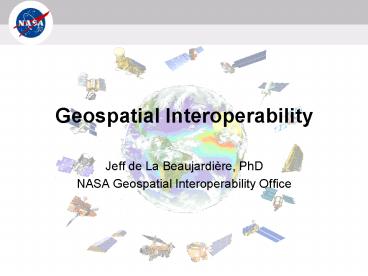Geospatial Interoperability - PowerPoint PPT Presentation
Title:
Geospatial Interoperability
Description:
Earth Science Gateway. Maps. Metadata. Coverages. Features. Geospatial ... Earth Science Gateway. Web Browser. Existing (OGC) Viewer Client. New WCS Request ... – PowerPoint PPT presentation
Number of Views:27
Avg rating:3.0/5.0
Title: Geospatial Interoperability
1
Geospatial Interoperability
- Jeff de La Beaujardière, PhD
- NASA Geospatial Interoperability Office
2
Overview
- Definition of geospatial interoperability
- NASA's Geospatial Interoperability Office (GIO)
- Geospatial Web Services
- Earth Science Gateway
3
Geospatial Information Content
Features Coverages
Metadata Maps
From Geospatial Interoperability Reference Model
(GIRM)
4
Transfer of Geospatial Information
- Recommended method
- Open-standard, vendor-neutral web services
- Interoperability among data/model/DSS components
- Each application can combine info from multiple
sources - Each source can serve multiple applications
- More specifically
- Standardized URL patterns for requesting
information - Metadata describing available content
- GIO can help you implement this method
- Expertise with each standard
- Influence with standards bodies
5
NASA Geospatial Interoperability Office
- GIO is a Level II (NASA-wide) function
- Manages NASA participation in geospatial
standards-developing organizations - FGDC (Federal Geographic Data Committee)
- OGC (Open GIS Consortium)
- ISO TC211 (Technical Committee for Geographic
Information/Geomatics) - Assesses represents Agency consensus on
standards - Ensures standards meet NASA needs
- Advocates assists Agency adoption of geospatial
standards - Standards Development Expertise
- Expertise in Standards Implementation
- Business perspective for alignments industry
partnerships
6
Geospatial Standards Bodies
- Open GIS Consortium
- www.opengis.org
- Not-for-profit consortium
- Vendor-neutral specifications
- ISO TC211- Geographic Information/Geomatics
- www.isotc211.org
- Technical Committee of ISO
- International Standards
- Federal Geographic Data Committee
- www.fgdc.gov
- US Federal government directive
- Federal standards
7
Geospatial Web Services (1)
- Web Map Service (WMS) (aka ISO DIS 19128)
- For pictures of data (GIF, PNG, JPEG, )
- Example solar or planetary image
- Web Coverage Service (WCS)
- For gridded data (GeoTIFF, HDF, )
- Example solar photospheric magnetic field
- Web Feature Service (WFS)
- For point/line/polygon data (XML/GML)
- Example in-situ data planetary surface features
8
Geospatial Web Services (1 1/2)
- Feature Portrayal Service ("SLD WMS")
- Reads feature data from WFS
- Returns map like WMS
- Coverage Portrayal Service (CPS)
- Reads coverage data from WCS
- Returns map like WMS
- Styled Layer Descriptors (SLD)
- XML description of how data should be rendered
into picture
9
Geospatial Web Services (2)
- WMS Context (XML file format)
- Save/restore composite map from multiple WMS
- Remembers bounding box other view params
- Web Terrain Service
- Perspective views of data draped over elevation
- 3D in 2D, but image pairs could be stereo
10
Geospatial Web Services (3)
- Sensor Planning Service
- Manage network of deployed in-situ sensors
- Catalog Services for Web (CS/W)
- Web-queryable catalog of data services
- Example search for multiple datasets needed for
research and automatically integrate into view - FGDC Clearinghouse
- Network of 200 catalogs (incl. NASA GCMD)
- Example find archival data not available from
web service and manually retrieve integrate
11
WMS Context Example
- using NASA WMS Viewer - viewer.digitalearth.gov
GLOBE
FGDC
JPL
12
Earth Science Gateway
National Application DSS
Terrain Cache
WS
WMS
http, WMS, Catalog
WMS
WS
http, WMS, Catalog
http, WMS
http, WMS
WS
Existing (OGC) Viewer Client Generator
Earth Science Gateway
New Coverage Portrayal Service
Catalog
OGC Web Services
JPL WMS
Other ESE
WMS
Synergy Data Pools
Other Organizations
National Application Data Centers
WMS Global Mosaic
Access to Grid Access to Models
WMS Global Mosaic
Existing
WCS, WMS (Data TBD)
WCS, WFS WMS, Catalog
WCS, WFS WMS, Catalog
Infomarts
Earth Observatory































